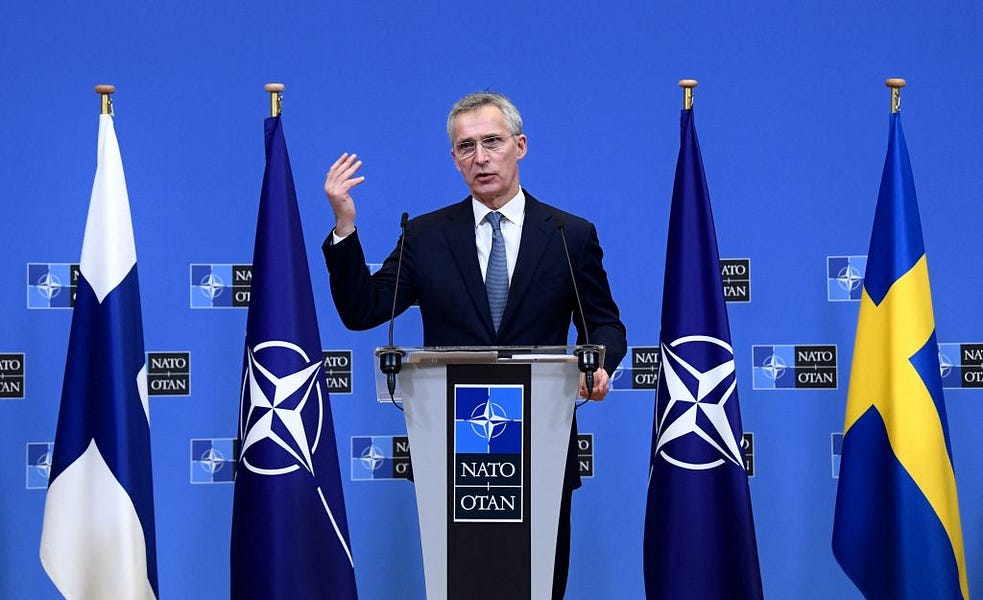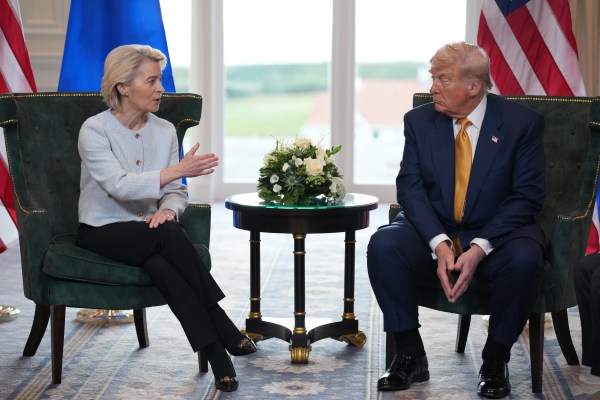A month before the invasion of Ukraine, on January 26, I wrote this in National Review on how getting Sweden and Finland to join NATO could help deter Putin:
Offering them full membership in NATO will not only give them Article 5 security against any future Russian incursions along their border. It will give Putin something to worry about regarding his very vulnerable northern frontier.
Now, two months into Putin’s invasion, it looks like what I urged is about to happen. According to a report in the Guardian, Sweden and Finland have agreed to submit simultaneous membership applications to the U.S.-led NATO alliance, perhaps as soon as mid-May.
The response from Moscow has been thunderous threats if the two Nordics dare to take this step. Swedes and Finns realize there are indeed risks to joining NATO—one reason why neither has until now, even though their Nordic neighbors Norway and Denmark were founding members in 1949. Nearly one quarter of the prospective members’ combined land mass lies above the Arctic Circle. Both have to be wondering if other NATO members will really risk going to war under Article 5 if Russia makes an aggressive move so far from the center of Europe. In addition, Finland shares an 830-mile border with Russia, along which Russians and Finns have fought for many years. If Russia was willing to risk all-out war to keep Ukraine out of NATO, skeptics ask, what will Moscow do to Finland when it votes to get in?
However, whatever doubts Finns and Swedes had before about joining NATO (and even before the Ukraine invasion, a 2021 poll showed that 46 percent of Swedes supported joining), the horrific images from Bucha and Mariupol of smashed apartment buildings and dead civilians have changed everyone’s perspective. Polls show as many as 68 percent of Finns are now in favor of joining the alliance, more than double the figure before the invasion, with only 12 percent against. Swedish supporters of membership are now firmly in the majority. Whatever else the war in Ukraine has done, it has revealed to Finns and Swedes that the very idea of national sovereignty is at existential risk, including their own, and that joining NATO is about stepping up with the rest of Europe, and the world, in defending that principle against totalitarian aggression.
Whatever the risks, then, joining NATO offers huge opportunities—not only for their own security and peace of mind but NATO itself, if the addition of these two Nordic nations are seen through the proper strategic lens.
Neither Swedes nor Finns have any illusion about who they’re dealing with when it comes to Russia, the Finns especially. Finland had to fight for its independence from Russia not once but three times in the first half of the 20th century; the country’s leadership was determined to avoid the same fate in the century’s second half, during the Cold War. The result was the Finnish version of neutrality, which meant seeing no evil, hearing no evil, and speaking no evil about the Soviet Union no matter how supine the policy appeared to others. That posture gave birth to a new word, Finlandization, to describe a policy of abject appeasement of a more powerful neighbor. Helsinki didn’t care. Not giving the Russians any excuse for another invasion was more important than being praised by American and European cold warriors.
In Sweden’s case, Swedes and their fellow Scandinavians in Norway and Denmark discovered the value of neutrality during World War I, when all three came out of the war enjoying a new era of affluence and prosperity while the economies of the combatants lay in ruins. The same happened after World War II. Sweden itself managed to stay aloof from the conflict even as the Nazis overran Denmark and Norway, although Stockholm earned the opprobrium of having supplied the Nazi war machine with iron ore until very late in the war. Still, the rapid GDP growth Sweden experienced after 1945 (averaging 5.3 percent between 1960 and 1965) seemed proof that choosing sides in a great power conflict was a game for others, but not for Swedes.
With the Cold War, therefore, Sweden decided the best way to avoid choosing sides was to remain out of NATO, while still maintaining a strong national army and navy and a robust defense industry. On the other hand, Norway and Denmark realized that NATO membership could add an extra layer of protection to their national status under the massive U.S. military umbrella and extended deterrence, while keeping them comfortably removed from the potential theater of conflict, which was Germany and Central Europe.
All the same, it’s a mistake to assume that because the Nordic countries, including Finland, are heavily invested in welfare-state politics they are somehow “soft” on defense, especially their own. Sweden has a modern, well-equipped military and is set to increase defense spending by 40 percent by 2025, the biggest increase in more than 70 years. Finland will soon reach NATO’s defense-spending guideline of 2 percent of GDP, a rate of military expenditures larger than Germany’s or Italy’s.
Meanwhile, a 2015 Gallup survey showed that 74 percent of Finns are prepared to fight for their country, compared with 18 percent of Germans.
In short, Finland and Sweden add important military assets to NATO, including isolating Russia’s enclave on the Baltic at Kaliningrad (formerly Koenigsberg), which threatens the three Baltic NATO members—Lithuania, Latvia, and Estonia—and Sweden’s Gotland Island, which is vital to Sweden’s air defense and naval operations. The idea of turning the Baltic Sea into a virtual NATO lake, with a vise-like squeeze on St Petersburg, will give Russian military and naval strategists something to worry about.
So will an expanded NATO presence in the newest strategic and economic frontier of the 21st century, the Arctic and North Pole.
As a document released by the U.S. Navy in January 2021 pointed out, because of climate change the Arctic Ocean is gradually turning from frozen “white” to navigable “blue,” which means nations bordering on its shores will have unprecedented access to new sea routes, natural resources, and international markets. This means in turn an increased role for navies to defend and extend those routes and economic zones. Among those powers that realize this potential is Russia, which has been heavily stepping up its military activities along its Arctic border.
The governing body of the Arctic region, and the key to making it a free and open and rule-based maritime area, is the multinational Arctic Council. Both Sweden and Finland are prominent members of the Arctic Council, along with Norway and Denmark as well as the U.S. and Canada. In fact, if Sweden and Finland join NATO, then seven of the eight national members will now be NATO countries. This will allow for economic as well as military and strategic cooperation bound to make Moscow realize that by invading Ukraine, instead of lessening their security risks they’ve only made them worse.
Mention of the Arctic Council means not forgetting its other Scandinavian member, namely Iceland. Iceland has been a NATO member since its founding, although the U.S. has not maintained any permanent military presence there since 2006. Still, a new agreement involving Iceland, the U.S., and NATO’s newest Nordic members regarding sea basing in the Arctic region, would be an excellent follow-up for protecting this increasingly significant part of the world.
In short, Finland and Sweden joining NATO could open an entirely new chapter for NATO, with enhanced Nordic membership and leadership. It could even give the word “Finlandization” a new, more robust meaning. This new chapter will not only force Moscow to rethink its plans for dominating its neighbors, but reassure Americans that maintaining our commitment to NATO can mean a new era of security for the world—one that still requires American leadership but not American boots on the ground.
Arthur Herman is a senior fellow at Hudson Institute and author, most recently, of The Viking Heart: How Scandinavians Conquered the World (2021).






Please note that we at The Dispatch hold ourselves, our work, and our commenters to a higher standard than other places on the internet. We welcome comments that foster genuine debate or discussion—including comments critical of us or our work—but responses that include ad hominem attacks on fellow Dispatch members or are intended to stoke fear and anger may be moderated.
With your membership, you only have the ability to comment on The Morning Dispatch articles. Consider upgrading to join the conversation everywhere.